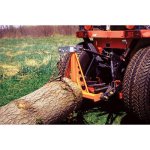Andy1969
Gold Member
- Joined
- Sep 19, 2017
- Messages
- 279
- Location
- Erie, Pa
- Tractor
- Mahindra 5155, 53 Farmall Cub. Yanmar 2210DB
From an engineering standpoint the top link must be in tension. Otherwise you couldn’t pick anything up. The only time a top link goes into compression is when something goes wrong such as not having it adjusted properly and brush hogging in hilly terrain. That’s why the better brush hogs have attachments designed to pivot to allow for that so your top link doesn’t see compression and buckle like a wet noodle. I don’t plan to go crazy with this hitch. But the idea of hooks up high is to hitch, lift the three point, and get thtbut end out of the dirt so it skids easier and safer. I’ll let you know how it goes next week if it dries out.

